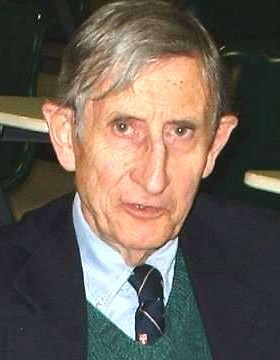This due is a beast, he knows both the physics and the history of physics, and has the patience to teach it. What a blessing: Section "How to teach and learn physics".
Ciro Santilli's admiration for Dyson goes beyond his "unify all the things approach", which Ciro loves, but also extends to the way he talks and the things he says. Dyson is one of Ciro's favorite physicist.
Besides this, he was also very idealistic compassionate, and supported a peaceful resolution until World War II with United Kingdom was basically inevitable. Note that this was a strategic mistake.
Dyson is "hawk nosed" as mentioned in Genius: Richard Feynman and Modern Physics by James Gleick (1994) chapter "Dyson". But he wasn't when he was young, see e.g. i2.wp.com/www.brainpickings.org/wp-content/uploads/2016/03/freemandyson_child-1.jpg?resize=768%2C1064&ssl=1 It seems that his nose just never stopped growing after puberty.
He also has some fun stories, like him practicing night climbing while at Cambridge University, and having walked from Cambridge to London (~86km!) in a day with his wheelchair bound friend.
Ciro Santilli feels that the label child prodigy applies even more so to him than to Feynman and Julian Schwinger.
Bibliography:
- QED and the men who made it: Dyson, Feynman, Schwinger, and Tomonaga by Silvan Schweber (1994) chapter 9 Freeman Dyson and the Structure of Quantum Field Theory
This is the one Ciro Santilli envies the most, because he has such a great overlap with Ciro's interests, e.g.:
John von Neuman - a documentary by the Mathematical Association of America (1966)
Source. Some good testimonies. Some boring.Web of Stories 1997 interview playlist: www.youtube.com/playlist?list=PLVV0r6CmEsFxKFx-0lsQDs6oLP3SZ9BlA
The way this dude speaks. He exhales incredible intelligence!!!
In the interviews you can see that he pronounces names in all languages amazingly, making acute effort to do so, to the point of being notable. His passion for linguistics is actually mentioned on Genius: Richard Feynman and Modern Physics by James Gleick (1994).
Maybe this obsession is partly due to his name which no English speaking person knows how to pronounce from the writing.
This passion also led in part for his names to some physics terminology he worked on winning out over alternatives by his collaborators, most notably in the case of the naming of the quark.
Participated in the German nuclear weapons program, ouch.
The dude was brutal. Ron Maimon praises that at youtu.be/ObXbKbpkSjQ?t=944 from Video "Ron Maimon interview with Jeff Meverson (2014)".
Figure "xkcd 435: Fields arranged by purity" must again be cited.
As of 2019, the more formal name for particle physics, which is notably missing general relativity to achieve the theory of everything.
cds.cern.ch/record/799984/files/0401010.pdf The Making of the Standard Model by Steven Weinberg mentions three crucial elements that made up the standard model post earlier less generalized quantum electrodynamics understandings
Existence and uniqueness of solutions of partial differential equations by  Ciro Santilli 40 Updated 2025-07-16
Ciro Santilli 40 Updated 2025-07-16
Unlike for ordinary differential equations which have the Picard–Lindelöf theorem, the existence and uniqueness of solution is not well solved for PDEs.
For example, Navier-Stokes existence and smoothness was one of the Millennium Prize Problems.
The website is the reference instance of OurBigBook Web, which is part of the OurBigBook Project, the other main part of the project are software that users can run locally to publish their content such as the OurBigBook CLI.
The project documentation is present at: docs.ourbigbook.com#ourbigbook-web-user-manual
The topics feature allows you to find the best version of a subject written by other users user
. Live demo: derivative.OurBigBook's weird specialization towards the weird overly niche interests of its creator Ciro Santilli, notably "I want to create the perfect documentation for every atom in the universe, is undoubtedly partly to blame for the project's failure to gain even a single user outside of its own creator.
However, Ciro does also believe that innovation requires to some degree specializing weirdly in some niche direction. Success comes perhaps from both going into a novel and valuable direction, while still being anatomic enough for enough people.
The reason public relations is evil in modern society is because, like discrimination, public relations works by dumb association and not logic or fairness.
If you're the son of the killer, you're fucked.
This is unlike our ideal for law which attempts, though sometimes fails, at isolating cause and effect.
Unlisted articles are being shown, click here to show only listed articles.



